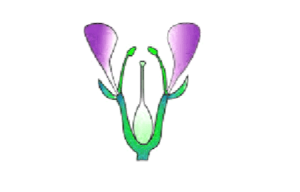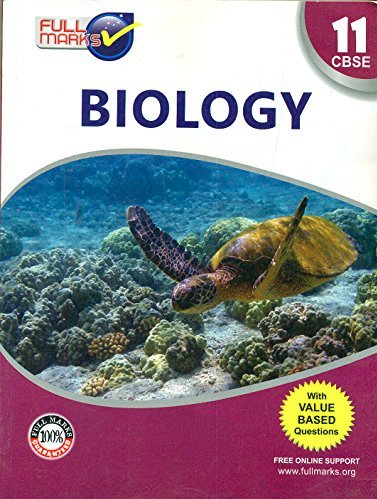1. What is meant by modification of root? What type of modification of root is found in the:
(a) Banyan tree (b) Turnip (c) Mangrove trees
Solution:
In order to carry out some secondary functions or a specific adaptation, roots modify their structures – which can be its size, shape, or even normal functioning. This is referred to as modification of roots.
a) In banyan trees, roots develop from the branches and they go deep down the earth to render mechanical assistance for the tree. This kind of modification is known as prop root.
b) In turnip, roots are modified to store food, and this type of modification is called a fleshy taproot.
c) In mangrove trees, the roots are modified into a pneumatic structure to provide oxygen to the tree. This type of modification is called respiratory roots or pneumatophores.
2. Justify the following statements on the basis of external features:
(i) Underground parts of a plant are not always roots.
(ii) The flower is a modified shoot.
Solution:
i) In a few plants like ginger, stems remain underground for vegetative reproduction and storage of food. Similarly stems in potato remains underground which are modified stems. Potato tuber indicate the presence of nodes (buds and scale leaves here) and internodes. Presence of an apical bud at the tip of potato tuber affirms it to be a stem. Hence, these examples show that underground parts are not always roots.
ii) Apical meristems give rise to floral meristems, and the axis of stem gets condensed while internodes lie nearer to each other. Because of this, floral appendages rise in place of stems, this justifies that flower is a modified shoot.
3. How is a pinnately compound leaf different from a palmately compound leaf?
Solution:
The differences are as follows:
Pinnately compound leaf
Palmately compound leaf
Many numbers of leaflets are present on a common axis
Several leaflets are attached to a common point.
Leaflets are attached to common axis called rachis
Leaflets are attached to a common point on the leaf stalk.
Leaflet bearing axis is the continuation of the petiole
Leaflet bearing axis is very short.
Ex: Neem leaves
Ex: Cotton leaves
4. Explain with suitable examples the different types of phyllotaxy.
Solution:
The pattern of leaf arrangement on the stem or branch is called phyllotaxy. Example in China rose, mustard and sunflower plants, a single leaf arises at each node alternately.
Phyllotaxy is of three types, namely:
Alternate – emergence of a single leaf at each node in an alternate manner. Example – Hibiscus
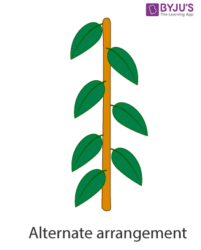
Whorled – whorl is formed when two or more leaves emerge at a node. Example – Alstonia
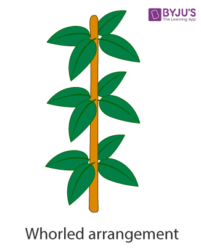
Opposite – emergence of a pair of leaves at every node, facing opposite to each other. Example – guava
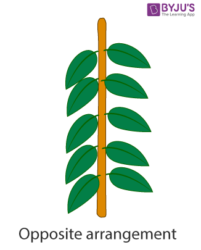
5. Define the following terms:
(a) aestivation
(b) placentation
(c) actinomorphic
(d) zygomorphic
(e) superior ovary
(f) perigynous flower
(g) epipetalous stamen
Solution:
a) Sepals or petals’ arrangement in a floral bud concerning other members of the same whorl is called as aestivation. Different types of aestivation are:
Twisted – if one margin of the appendage overlaps the adjacent one, it is twisted, which can either be clockwise or anti-clockwise. Example – cotton
Valvate – In a whorl when petals or sepals just touch each other at the margin without overlapping, it is valvate. Example – Calotropis
Imbricate – It is imbricate when petals or sepals overlap each other but not in any definite direction as observed in gulmohar
Vexillary – The largest petal overlaps the two lateral petals which in turn overlap the two smallest anterior peel is vexillary aestivation. Example – Bean flower
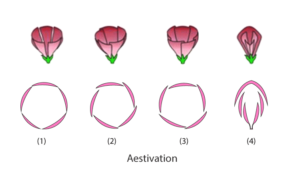
b) Arrangement of ovule within the ovary is known as placentation. They are of the following types:
Marginal – Placenta forms a ridge along through the ventral suture of the ovary, ovules are borne on the ridge to form two rows. Example – Pea
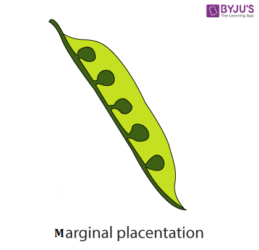
Axile – placenta is axial and ovules are attached to it in a multilocular ovary. Example – lemon
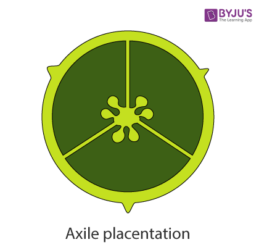
Basal – Placenta develops at the base of the ovary wherein a single ovule is attached to it. Example – Marigold
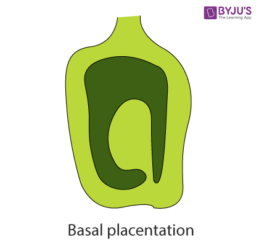
Free central –ovules are borne on the central axis and septa is absent. Example – Primrose
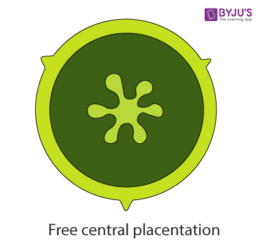
c) Flowers which can be divided into two halves by any vertical planes are known as actinomorphic flowers. Example – Chilli
d) Flower which has bilateral symmetry and can be divided into two halves only in one plane is known as a zygomorphic flower. Example – Gulmohar
e) In Hypogynous flower the gynoecium occupies the highest position while other parts remain below it. Ovary in such a flower is known as superior ovary. Example – Brinjal
f)A perigynous flower is the one in which gynoecium is situated in the centre and other parts of the flower are located on the rim of the thalamus. Ovary is half inferior. Example – Rose
g) Epipetalous stamen – Instead of directly being inserted over the thalamus, it has a stamen which is borne over a petal. Example – Brinjal
6. Differentiate between
(a) Racemose and cymose inflorescence
(b) Fibrous root and adventitious root
(c) Apocarpous and syncarpous ovary
Solution:
The differences are as follows:
(a) Racemose and cymose inflorescence
Racemose inflorescence
Cymose inflorescence
Inflorescence in which young flowers are present at the tip and older flowers are arranged at the base
Inflorescence in which old flowers are present at the tip and young flowers are arranged at the base
Main axis continues to grow and produce flowers laterally.
The main axis has limited growth which terminates into flower.
(b) Fibrous root and adventitious root
Fibrous roots
Adventitious roots
The primary root is short-lived and is replaced by a large number of roots in monocotyledons
Roots arise from parts of the plants other the radicle.
Example: Wheat
Example: Banyan tree
(c) Apocarpous and syncarpous ovary
Apocarpous ovary
Syncarpous ovary
In apocarpous ovary, two or more carpels are free
In syncarpous ovary, two or more carpels are fused
Example: Lotus
Example : mustard
7. Draw the labelled diagram of the following: (i) gram seed (ii) V.S. of maize seed
Solution:
(i) Gram seed
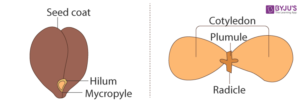
(ii) V.S. of maize seed
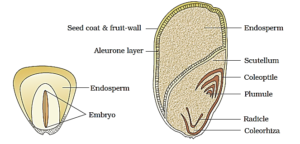
8. Describe modifications of stem with suitable examples
Solution:
Modifications of stem:
Food storage:
Underground stems of potato ginger, turmeric are modified to store food in them. They act as organs of perennation to tide over conditions unfavourable for growth.
Tendrils:
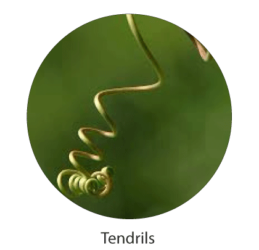
Tendrils are slender, spirally coiled which develop from axillary buds. These stem tendrils help plants to climb such as in gourds (cucumber, pumpkins, watermelon) and grapevines.
Thorns:
Stems of auxiliary buds get modified into woody, straight and pointed thorns. Thorns protect plants from animals. Several plants of dry regions alter their stems into either fleshy cylindrical structures or flattened. Ex: citrus
plants. They possess chlorophyll and perform photosynthesis.
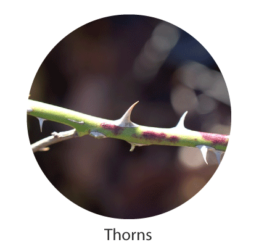
Other modifications:
Vegetative reproduction:
Underground stems of some plants such as grass and strawberry, etc., spread to new niches and when older parts die new plants are formed. In plants like mint and jasmine, a slender lateral branch arises from the base of the main axis and after growing aerially for some time arch downwards to touch the ground.
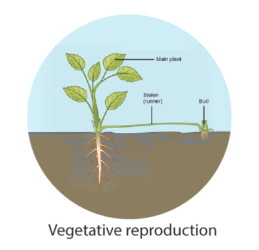
9. Take one flower each of the families Fabaceae and Solanaceae and write its semi-technical description. Also, draw their floral diagram after studying them.
Characters of Fabaceae
They are trees, shrubs herbs having roots with root nodules.
Stems are erect or climber
Leaves are alternate, pinnately compound or simple and leaf base are pulvinate; stipulate with reticulate venation.
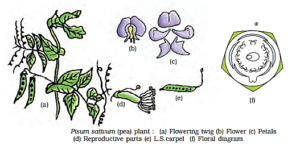
Inflorescence: racemose
Flower: bisexual, zygomorphic
Calyx: sepals five, gamosepalous; valvate/imbricate aestivation
Corolla: petals five, polypetalous, papilionaceous, consisting of a posterior standard, two lateral wings, two anterior ones forming a keel (enclosing stamens and pistil), vexillary aestivation
Androecium: stamens ten in number, diadelphous, anther dithecous
Gynoecium: ovary superior, monocarpellary, unilocular with many ovules, style single
Fruit: legume; seed: one to many, non-endospermic
Economic importance:
Plants of these families are pulses used as fodder and sweet pea.
Ex: Peas, trifolium,
Floral diagram:
![]()
Characters of Solanaceae
Commonly termed as potato family, Solanaceae are mostly herbs, shrubs and rarely small trees
Stems are herbaceous rarely woody, aerial; erect, cylindrical, branched, solid or hollow, hairy or glabrous,
underground stem in potato.
Leaves are alternate, simple, rarely pinnately compound, exstipulate with reticulate venation.
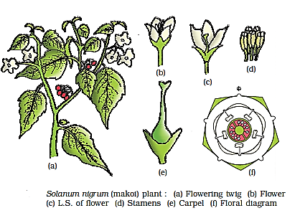
Floral Characters
Inflorescence: Solitary, axillary or cymose as in Solanum
Flower: bisexual, actinomorphic
Calyx: sepals five, united, persistent, valvate aestivation
Corolla: petals five, united; valvate aestivation
Androecium: stamens five, epipetalous
Gynoecium: bicarpellary obligately placed, syncarpous; ovary superior, bilocular, placenta is swollen with many ovules, axile
Fruits: berry or capsule
Seeds: many, endosperms
Economic importance
Plants belonging to this family are used as food, spices, medicines and ornamentals
Floral diagram:

Ex: Brinjal, chilli, ashwagandha, petunia
10. Describe the various types of placentations found in flowering plants.
Solution:
Various types of placentations found in flowering plants are as follows
Marginal – Placenta forms a ridge along through the ventral suture of the ovary, ovules are borne on the ridge to form two rows. Example – Pea
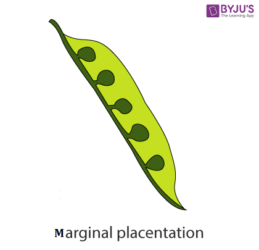
Axile – placenta is axial and ovules are attached to it in a multilocular ovary. Example – lemon
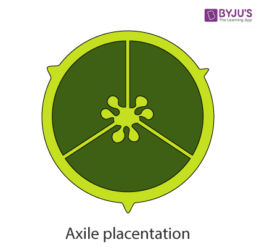
Parietal – ovules develop on the inner wall of the ovary or on the peripheral. It is single-chambered, but due to formation of a false septum, it becomes two-chambered. Example – Mustard
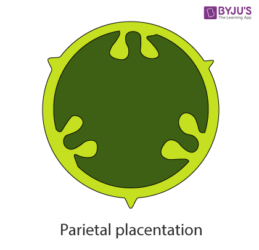
Basal – Placenta develops at the base of the ovary wherein a single ovule is attached to it. Example – Marigold

Free central –ovules are borne on the central axis and septa is absent. Example – Primrose
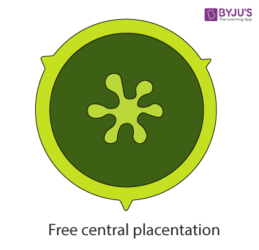
11. What is a flower? Describe the parts of a typical angiosperm flower
Solution:
Reproductive part of an angiosperm is called as the flower. It is a modified shoot wherein the shoot apical meristem changes to floral meristem.
A typical flower has four different kinds of whorls that are organized successively on the swollen end of the pedicel or stalk known as receptacle or thalamus. These four parts are classified under accessory organs and reproductive organs. When the calyx and corolla are not distinct, they are termed as perianth.
The accessory organs are calyx and corolla, the reproductive organs are androecium and gynoecium
Parts of the flower are as follows
1.Calyx:
It is the lowermost and outermost whorl of the flower, and they are called sepals. They render support and protection to other floral structures.
2.Corolla:
Corolla are composed of petals which are brightly coloured to attract insects for pollination. Located inner to the sepals and outside the stamens.
3.Androecium:
Androecium consists of stamens which represent male reproductive organs of a stalk, filament and an anther.
Anthers are bilobed, where each lobe has two chambers, the pollen sacs where pollen grains are produced. The stamens may be united with other members namely petals or amongst themselves.
4.Gynoecium:
Gynoecium is the female reproductive part of a flower which is made of one or more carpels, which in turn is composed of three parts – stigma, ovary, and style. The ovary is found at the base, enlarged bearing the style, which is an elongated tube. Ovary is connected to the stigma through the style, the tip of which bears the stigma where pollen grains are received. Each of the ovaries bears one or more ovules attached to the placenta.
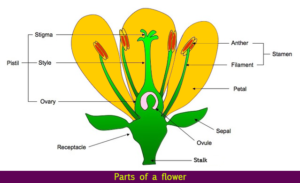
12. How do the various leaf modifications help plants?
Solution:
Leaves fundamentally perform photosynthesis. But in some plants, leaves are modified to carry out different functionalities, mentioned as below:
Tendrils: Tendrils helps for climbing as in peas
Spines: Thorns are modified leaves which will protect plants from animals, serving as an organ of defense.
Pitcher: Leaves of this plant are modified into pitcher-like structures containing digestive juices aiding in trapping and digesting insects.
Synthesis of food: Fleshy leaves of garlic and onion store some food. These are modified leaves. Phyllodes emerging from the petioles of leaves synthesize food. Phyllodes are flattened, green structures that replace the short-lived leaves.
13. Define the term inflorescence. Explain the basis for the different types of inflorescence in flowering plants.
Solution:
Inflorescence is the arrangement of flowers on the floral axis.
There are two major types of the inflorescence depending upon whether the apex is converted into a flower or continues to grow, they are:
Racemose: Type of inflorescence in which the flowers are borne laterally in acropetal succession, i.e, newer flowers are near the apex while older flowers are at the base. The main axis continues to
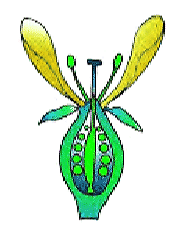
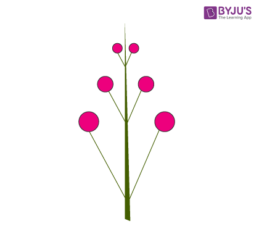
Cymose: is a type of inflorescence in which main axis terminates in a flower and has limited growth. Flowers are borne in a basipetal order where younger flowers are near the base and older flowers are at the apex.
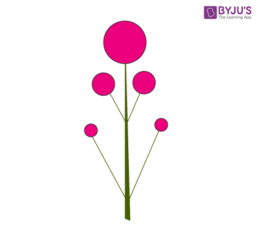
14. Write the floral formula of a actinomorphic, bisexual, hypogynous flower with five united sepals, five free petals, five free stamens and two united carples with superior ovary and axile placentation.
Solution:
The floral formula is as follows:
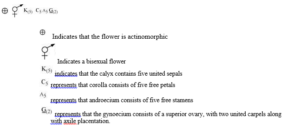
15. Describe the arrangement of floral members in relation to their insertion on thalamus.
Solution:
The arrangement of floral members in relation to their insertion on thalamus are of three types:
Hypogynous flowers are the ones in which gynoecium occupies the highest position while the other parts are situated below it, the ovary is said to be superior. Example – Brinjal

Perigynous flowers are the ones in which gynoecium stays in the center and other parts of the flower are located on the rim of the thalamus almost at the same level. Ovary is said to be half inferior. Example – Rose
